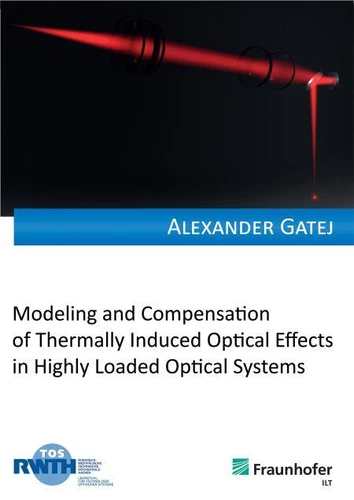Modeling and Compensation of Thermally Induced Optical Effects in Highly Loaded Optical Systems
Par :Formats :
Disponible dans votre compte client Decitre ou Furet du Nord dès validation de votre commande. Le format ePub est :
- Compatible avec une lecture sur My Vivlio (smartphone, tablette, ordinateur)
- Compatible avec une lecture sur liseuses Vivlio
- Pour les liseuses autres que Vivlio, vous devez utiliser le logiciel Adobe Digital Edition. Non compatible avec la lecture sur les liseuses Kindle, Remarkable et Sony
 , qui est-ce ?
, qui est-ce ?Notre partenaire de plateforme de lecture numérique où vous retrouverez l'ensemble de vos ebooks gratuitement
Pour en savoir plus sur nos ebooks, consultez notre aide en ligne ici
- FormatePub
- ISBN8215024874
- EAN9798215024874
- Date de parution20/09/2022
- Protection num.pas de protection
- Infos supplémentairesepub
- ÉditeurWMG Publishing
Résumé
Thermal lensing in optical systems for laser beam guiding and shaping is a highly up-to-date topic touching many fields of science and application. The development of thermally stable optical systems requires, from an engineering point of view, the improvement of current simulation models to enable a comprehensive modeling of thermal lensing in order to enable the optimization of optical systems in the early design stage.
For the first time, this dissertation enables a holistic modeling of thermal lensing due to arbitrary temperature profiles based on numerical methods for a mathematically and physically valid coupling of thermo-mechanical and optical simulation tools. Based on these developments, simulative and experimental analyses of thermal lensing are conducted and methodologies for the compensation of thermal lensing and the derivation of material data based on a sophisticated combination of measured and simulated values are derived.
For the first time, this dissertation enables a holistic modeling of thermal lensing due to arbitrary temperature profiles based on numerical methods for a mathematically and physically valid coupling of thermo-mechanical and optical simulation tools. Based on these developments, simulative and experimental analyses of thermal lensing are conducted and methodologies for the compensation of thermal lensing and the derivation of material data based on a sophisticated combination of measured and simulated values are derived.
Thermal lensing in optical systems for laser beam guiding and shaping is a highly up-to-date topic touching many fields of science and application. The development of thermally stable optical systems requires, from an engineering point of view, the improvement of current simulation models to enable a comprehensive modeling of thermal lensing in order to enable the optimization of optical systems in the early design stage.
For the first time, this dissertation enables a holistic modeling of thermal lensing due to arbitrary temperature profiles based on numerical methods for a mathematically and physically valid coupling of thermo-mechanical and optical simulation tools. Based on these developments, simulative and experimental analyses of thermal lensing are conducted and methodologies for the compensation of thermal lensing and the derivation of material data based on a sophisticated combination of measured and simulated values are derived.
For the first time, this dissertation enables a holistic modeling of thermal lensing due to arbitrary temperature profiles based on numerical methods for a mathematically and physically valid coupling of thermo-mechanical and optical simulation tools. Based on these developments, simulative and experimental analyses of thermal lensing are conducted and methodologies for the compensation of thermal lensing and the derivation of material data based on a sophisticated combination of measured and simulated values are derived.



